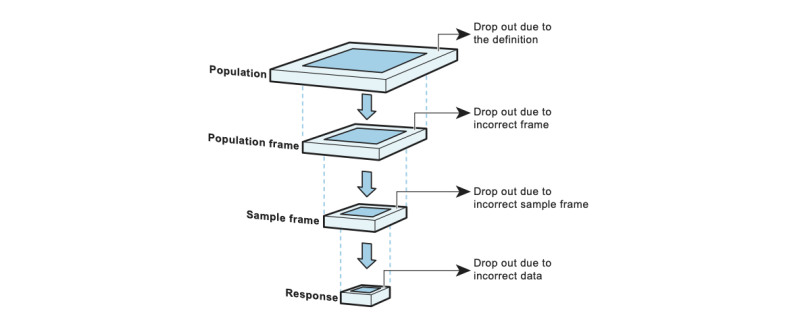
Non-response
The people who do not respond on a call to participate in a research are called the non-respondents. Non-response can seriously damage your research.
People are never obliged to participate in a research. The people who do participate are called respondents and they form the response group. The people who do not participate are non-respondents and they form the non-response group. It’s clear that non-response is the complement of the response; together they form the sample.
Reasons for non-response
Most of the time the reason for not responding to the invitation to participate are rather legal. Lets give a short list:
- No time
- Forgot it
- Not interested in any research
- Not interested in the topic of this research
- Didn’t get the invitation
- Lost the invitation
- Disabled
- Doesn’t have a computer or a connection with internet
- To old
- Cannot read
- Doesn’t understand the questions
- Speaks a foreign language
If you want to avoid these reasons for not responding, then try to do something against it. Sometimes it is easy. To do something against reason number two, five and six in the list above, a reminder can be sent. If a person cannot read or has bad eyesight (reason number twelve and seven), an interviewer can be sent. For almost any obstruction for not responding a solution can be found. This may take some time, effort and money. Depending om how much time, money or effort can be spent the non-response can be reduced to a very low percentage.
Non-response or drop out
Only for people the term non-response is used. For animals, plants and objects drop out is a more suitable term. A drop out is a deliberately deleted object or respondent by the researcher. To delete objects or respondents is always disputable. Read more about this on our page drops outs in this dictionary.
Why non-response should be avoided
Non-response can harm your research badly. First of all, a minimal response is needed to allow statistical testing. If the response doesn’t reach this minimal number of response, the results of the analysis become unstable, maybe they even lose their impact because they cannot become statistical significant anymore. (Also beware for the opposite: if the response is to big any statistical analysis will become significant.) Now it is impossible to draw correct conclusions out of the research: if there is no statistical significance, the conclusion is drawn there is no relation. And if there is no relation the researcher will conclude this has no impact. However, if the response would be big enough the opposite conclusion would have been drawn.
Secondly, non-response can be harmful for the representativity. This will be the case when the non-response is selective. In a research which has the purpose to make statements about all inhabitants of a country, there need to be response from every group. If the response of elder people is missing, any statement based of the analysis of the response is only allowed four the young inhabitants of that country.
If you have to handle with a non-representative response you can take action by weighting the results. This however isn’t always possible. Other ways to handle this, is treated in our paper Representativity.




